University Nursing Report: Learning Contract on Chest Tube Drainage
VerifiedAdded on 2023/04/11
|15
|3726
|286
Report
AI Summary
This report provides a comprehensive overview of chest tube drainage, a critical procedure in healthcare. It defines chest tubes, their purpose in draining fluids or air from the chest cavity, and the rationale behind their use in various medical conditions such as pneumothorax, pleural effusion, and e...

Running head: LEARNING CONTRACT
LEARNING CONTRACT
Name of the Student:
Name of the University:
Author Note:
LEARNING CONTRACT
Name of the Student:
Name of the University:
Author Note:
Paraphrase This Document
Need a fresh take? Get an instant paraphrase of this document with our AI Paraphraser
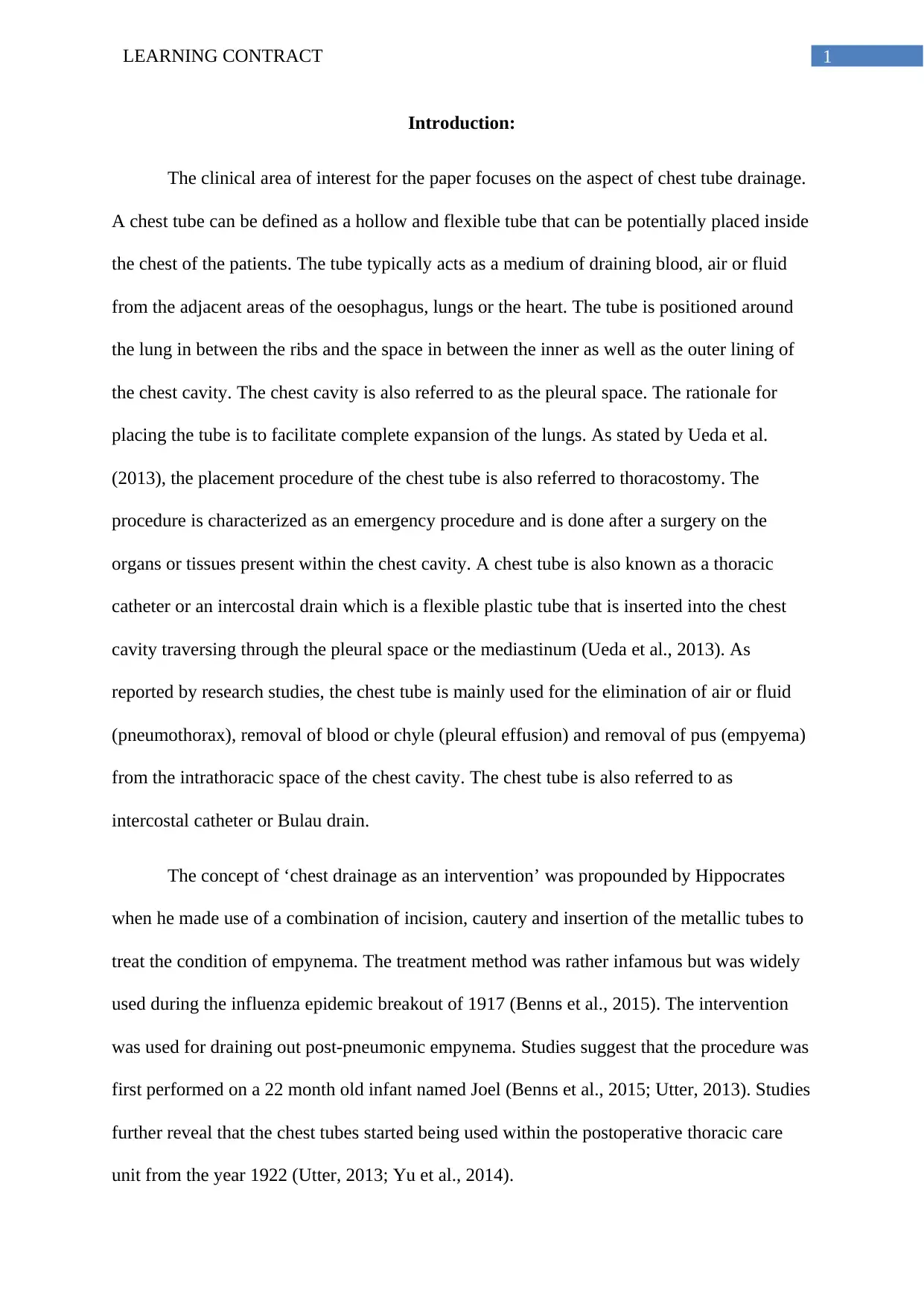
1LEARNING CONTRACT
Introduction:
The clinical area of interest for the paper focuses on the aspect of chest tube drainage.
A chest tube can be defined as a hollow and flexible tube that can be potentially placed inside
the chest of the patients. The tube typically acts as a medium of draining blood, air or fluid
from the adjacent areas of the oesophagus, lungs or the heart. The tube is positioned around
the lung in between the ribs and the space in between the inner as well as the outer lining of
the chest cavity. The chest cavity is also referred to as the pleural space. The rationale for
placing the tube is to facilitate complete expansion of the lungs. As stated by Ueda et al.
(2013), the placement procedure of the chest tube is also referred to thoracostomy. The
procedure is characterized as an emergency procedure and is done after a surgery on the
organs or tissues present within the chest cavity. A chest tube is also known as a thoracic
catheter or an intercostal drain which is a flexible plastic tube that is inserted into the chest
cavity traversing through the pleural space or the mediastinum (Ueda et al., 2013). As
reported by research studies, the chest tube is mainly used for the elimination of air or fluid
(pneumothorax), removal of blood or chyle (pleural effusion) and removal of pus (empyema)
from the intrathoracic space of the chest cavity. The chest tube is also referred to as
intercostal catheter or Bulau drain.
The concept of ‘chest drainage as an intervention’ was propounded by Hippocrates
when he made use of a combination of incision, cautery and insertion of the metallic tubes to
treat the condition of empynema. The treatment method was rather infamous but was widely
used during the influenza epidemic breakout of 1917 (Benns et al., 2015). The intervention
was used for draining out post-pneumonic empynema. Studies suggest that the procedure was
first performed on a 22 month old infant named Joel (Benns et al., 2015; Utter, 2013). Studies
further reveal that the chest tubes started being used within the postoperative thoracic care
unit from the year 1922 (Utter, 2013; Yu et al., 2014).
Introduction:
The clinical area of interest for the paper focuses on the aspect of chest tube drainage.
A chest tube can be defined as a hollow and flexible tube that can be potentially placed inside
the chest of the patients. The tube typically acts as a medium of draining blood, air or fluid
from the adjacent areas of the oesophagus, lungs or the heart. The tube is positioned around
the lung in between the ribs and the space in between the inner as well as the outer lining of
the chest cavity. The chest cavity is also referred to as the pleural space. The rationale for
placing the tube is to facilitate complete expansion of the lungs. As stated by Ueda et al.
(2013), the placement procedure of the chest tube is also referred to thoracostomy. The
procedure is characterized as an emergency procedure and is done after a surgery on the
organs or tissues present within the chest cavity. A chest tube is also known as a thoracic
catheter or an intercostal drain which is a flexible plastic tube that is inserted into the chest
cavity traversing through the pleural space or the mediastinum (Ueda et al., 2013). As
reported by research studies, the chest tube is mainly used for the elimination of air or fluid
(pneumothorax), removal of blood or chyle (pleural effusion) and removal of pus (empyema)
from the intrathoracic space of the chest cavity. The chest tube is also referred to as
intercostal catheter or Bulau drain.
The concept of ‘chest drainage as an intervention’ was propounded by Hippocrates
when he made use of a combination of incision, cautery and insertion of the metallic tubes to
treat the condition of empynema. The treatment method was rather infamous but was widely
used during the influenza epidemic breakout of 1917 (Benns et al., 2015). The intervention
was used for draining out post-pneumonic empynema. Studies suggest that the procedure was
first performed on a 22 month old infant named Joel (Benns et al., 2015; Utter, 2013). Studies
further reveal that the chest tubes started being used within the postoperative thoracic care
unit from the year 1922 (Utter, 2013; Yu et al., 2014).

2LEARNING CONTRACT
The process of breathing is automatic and is guided by the mechanism of inhalation of
oxygen and exhalation of carbon dioxide from the body. It is important to note here that the
lack of sufficient ventilation or an impairment within the respiratory system can lead to a
fatal condition. It is therefore crucial for the healthcare professionals to develop a sound
understanding about the nuances of the pulmonary function. It is important for nurses as well
as care professionals to understand that performing critical procedures such as placement of
the chest tube is essential for sustaining life (Zardo et al., 2015). Also, nurses must possess a
strong understanding of the pulmonary pathophysiology and the factors that promote
effective gaseous exchange. In addition to this, care professionals must also be aware about
the risk factors that are associated with the incorrect placement and insertion of the chest
tube. Care professionals must also possess an understanding about the preparation of the
chest drainage unit, conduct assessment, document the procedure and escalate possible risks
that are associated with the procedure (Yu et al., 2014; Zardo et al., 2015).
Therefore, on the basis of the background information, it can be stated that the
identified clinical area of interest is challenging and requires optimal education and training
in order to ensure positive patient outcome. The following learning objectives can hence be
articulated for the learning contract:
Ability to learn about the after-care procedure that must be followed while caring
for patients with chest tube insertion
This would enable the nurses to learn about the routine after care procedure that must
be followed while caring for patients with a chest-tube insertion Ability to develop a conceptual understanding about the process of drainage
Developing an understanding about the process of drainage would facilitate
convenience while performing the procedure
The process of breathing is automatic and is guided by the mechanism of inhalation of
oxygen and exhalation of carbon dioxide from the body. It is important to note here that the
lack of sufficient ventilation or an impairment within the respiratory system can lead to a
fatal condition. It is therefore crucial for the healthcare professionals to develop a sound
understanding about the nuances of the pulmonary function. It is important for nurses as well
as care professionals to understand that performing critical procedures such as placement of
the chest tube is essential for sustaining life (Zardo et al., 2015). Also, nurses must possess a
strong understanding of the pulmonary pathophysiology and the factors that promote
effective gaseous exchange. In addition to this, care professionals must also be aware about
the risk factors that are associated with the incorrect placement and insertion of the chest
tube. Care professionals must also possess an understanding about the preparation of the
chest drainage unit, conduct assessment, document the procedure and escalate possible risks
that are associated with the procedure (Yu et al., 2014; Zardo et al., 2015).
Therefore, on the basis of the background information, it can be stated that the
identified clinical area of interest is challenging and requires optimal education and training
in order to ensure positive patient outcome. The following learning objectives can hence be
articulated for the learning contract:
Ability to learn about the after-care procedure that must be followed while caring
for patients with chest tube insertion
This would enable the nurses to learn about the routine after care procedure that must
be followed while caring for patients with a chest-tube insertion Ability to develop a conceptual understanding about the process of drainage
Developing an understanding about the process of drainage would facilitate
convenience while performing the procedure
You're viewing a preview
Unlock full access by subscribing today!
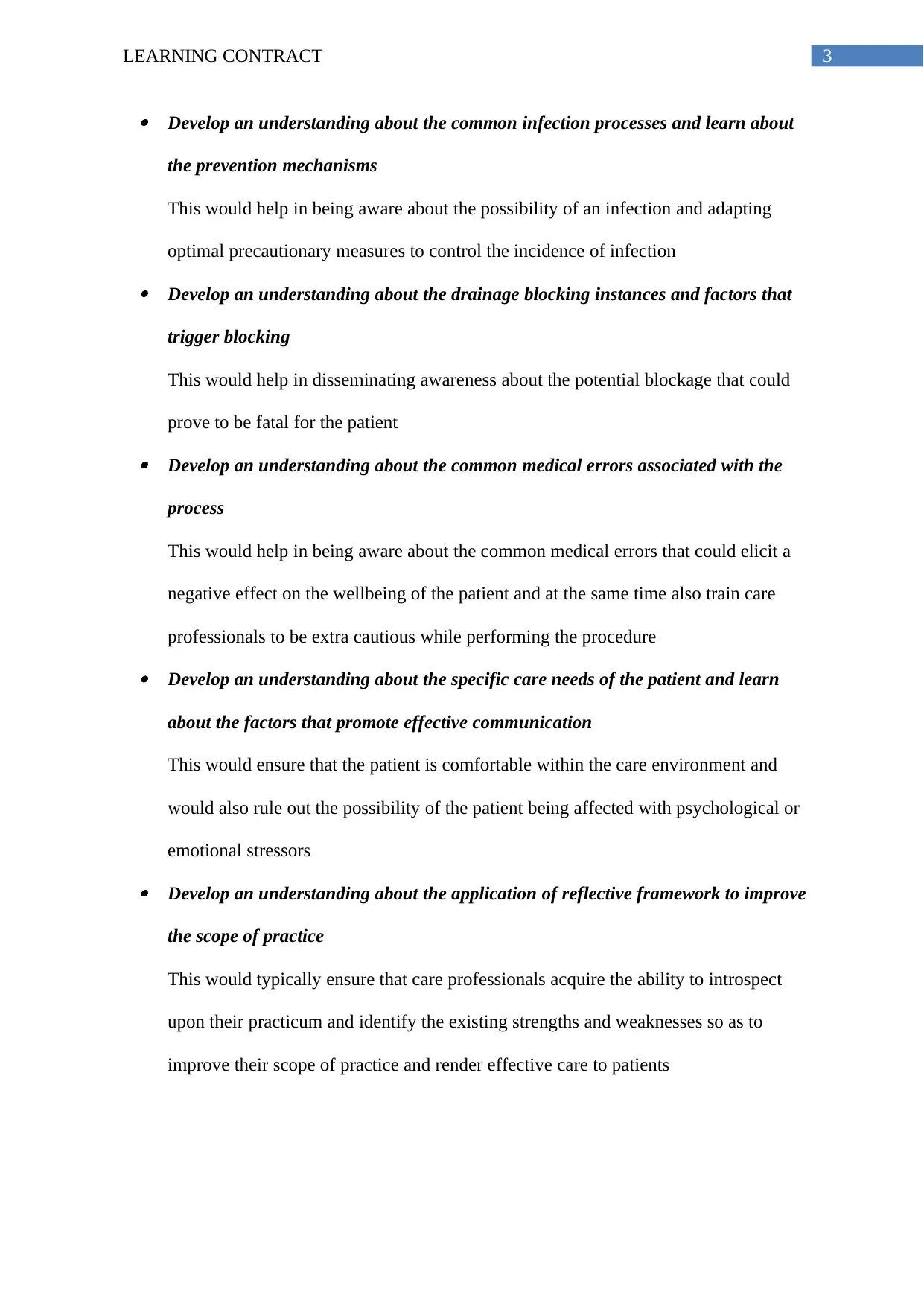
3LEARNING CONTRACT
Develop an understanding about the common infection processes and learn about
the prevention mechanisms
This would help in being aware about the possibility of an infection and adapting
optimal precautionary measures to control the incidence of infection Develop an understanding about the drainage blocking instances and factors that
trigger blocking
This would help in disseminating awareness about the potential blockage that could
prove to be fatal for the patient Develop an understanding about the common medical errors associated with the
process
This would help in being aware about the common medical errors that could elicit a
negative effect on the wellbeing of the patient and at the same time also train care
professionals to be extra cautious while performing the procedure Develop an understanding about the specific care needs of the patient and learn
about the factors that promote effective communication
This would ensure that the patient is comfortable within the care environment and
would also rule out the possibility of the patient being affected with psychological or
emotional stressors Develop an understanding about the application of reflective framework to improve
the scope of practice
This would typically ensure that care professionals acquire the ability to introspect
upon their practicum and identify the existing strengths and weaknesses so as to
improve their scope of practice and render effective care to patients
Develop an understanding about the common infection processes and learn about
the prevention mechanisms
This would help in being aware about the possibility of an infection and adapting
optimal precautionary measures to control the incidence of infection Develop an understanding about the drainage blocking instances and factors that
trigger blocking
This would help in disseminating awareness about the potential blockage that could
prove to be fatal for the patient Develop an understanding about the common medical errors associated with the
process
This would help in being aware about the common medical errors that could elicit a
negative effect on the wellbeing of the patient and at the same time also train care
professionals to be extra cautious while performing the procedure Develop an understanding about the specific care needs of the patient and learn
about the factors that promote effective communication
This would ensure that the patient is comfortable within the care environment and
would also rule out the possibility of the patient being affected with psychological or
emotional stressors Develop an understanding about the application of reflective framework to improve
the scope of practice
This would typically ensure that care professionals acquire the ability to introspect
upon their practicum and identify the existing strengths and weaknesses so as to
improve their scope of practice and render effective care to patients
Paraphrase This Document
Need a fresh take? Get an instant paraphrase of this document with our AI Paraphraser

4LEARNING CONTRACT
Content and Analysis:
Research studies suggest that the chest tube is widely used in case of abnormal
physiological conditions such as a collapsed lung or a lung infection (Chen et al., 2013). In
addition to this, in cases of bleeding around the lung after a traumatic injury or an accident or
a fluid build-up on account of other disorders such as pneumonia or cancer, chest tubes are
invariably used for the drainage of chest. In addition to this, the drainage of chest intervention
is also used when the patient is experiencing a difficulty in breathing due to the accumulation
of fluid or air or after a surgery in the vital organs that include the heart, lungs or the
oesophagus. As stated by Foroulis et al.(2014), it has further been mentioned that the
insertion of chest tube also helps the physician in diagnosing an internal damage or an injury
within the lungs.
It is important to note in this context that the procedure of chest tube insertion is
governed by a number of risk factors. The procedure has been reported to cause a number of
complications that include pain during the placement, emergence of infection, bleeding and
faulty tube placement. According to Kuhajda et al. (2014), the procedure of chest tube
placement is extremely painful and the process is generally performed after an anaesthesia.
The mechanism of delivering anaesthesia can either be general anaesthesia or local
anaesthesia. Local anaesthesia is preferred over general anaesthesia and it displays its effect
by rendering numbness at the site of administration. In addition to this, it should be noted
here that the process of the chest tube placement is an invasive procedure which enhances the
risk of developing an infection (Cooke & David, 2013). The risk of developing an infection
can be effectively managed with the use of sterile surgical tools while performing the
procedure. Also, while performing the procedure, there might be a slight damage caused to
the blood vessels within the chest cavity which could lead to bleeding. Research studies
further suggest a number of cases where the chest tube can be placed either too far inside or
Content and Analysis:
Research studies suggest that the chest tube is widely used in case of abnormal
physiological conditions such as a collapsed lung or a lung infection (Chen et al., 2013). In
addition to this, in cases of bleeding around the lung after a traumatic injury or an accident or
a fluid build-up on account of other disorders such as pneumonia or cancer, chest tubes are
invariably used for the drainage of chest. In addition to this, the drainage of chest intervention
is also used when the patient is experiencing a difficulty in breathing due to the accumulation
of fluid or air or after a surgery in the vital organs that include the heart, lungs or the
oesophagus. As stated by Foroulis et al.(2014), it has further been mentioned that the
insertion of chest tube also helps the physician in diagnosing an internal damage or an injury
within the lungs.
It is important to note in this context that the procedure of chest tube insertion is
governed by a number of risk factors. The procedure has been reported to cause a number of
complications that include pain during the placement, emergence of infection, bleeding and
faulty tube placement. According to Kuhajda et al. (2014), the procedure of chest tube
placement is extremely painful and the process is generally performed after an anaesthesia.
The mechanism of delivering anaesthesia can either be general anaesthesia or local
anaesthesia. Local anaesthesia is preferred over general anaesthesia and it displays its effect
by rendering numbness at the site of administration. In addition to this, it should be noted
here that the process of the chest tube placement is an invasive procedure which enhances the
risk of developing an infection (Cooke & David, 2013). The risk of developing an infection
can be effectively managed with the use of sterile surgical tools while performing the
procedure. Also, while performing the procedure, there might be a slight damage caused to
the blood vessels within the chest cavity which could lead to bleeding. Research studies
further suggest a number of cases where the chest tube can be placed either too far inside or
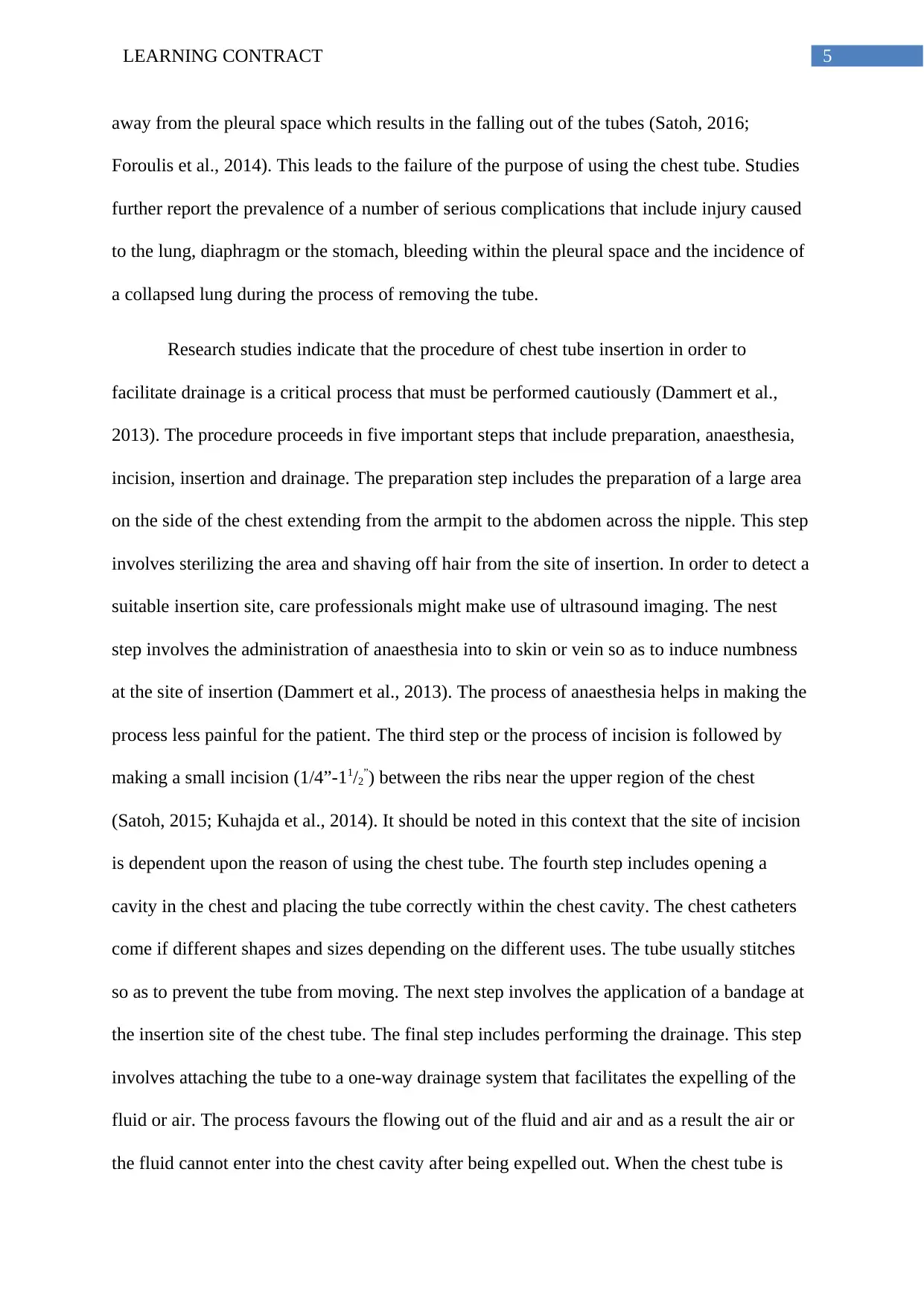
5LEARNING CONTRACT
away from the pleural space which results in the falling out of the tubes (Satoh, 2016;
Foroulis et al., 2014). This leads to the failure of the purpose of using the chest tube. Studies
further report the prevalence of a number of serious complications that include injury caused
to the lung, diaphragm or the stomach, bleeding within the pleural space and the incidence of
a collapsed lung during the process of removing the tube.
Research studies indicate that the procedure of chest tube insertion in order to
facilitate drainage is a critical process that must be performed cautiously (Dammert et al.,
2013). The procedure proceeds in five important steps that include preparation, anaesthesia,
incision, insertion and drainage. The preparation step includes the preparation of a large area
on the side of the chest extending from the armpit to the abdomen across the nipple. This step
involves sterilizing the area and shaving off hair from the site of insertion. In order to detect a
suitable insertion site, care professionals might make use of ultrasound imaging. The nest
step involves the administration of anaesthesia into to skin or vein so as to induce numbness
at the site of insertion (Dammert et al., 2013). The process of anaesthesia helps in making the
process less painful for the patient. The third step or the process of incision is followed by
making a small incision (1/4”-11/2”) between the ribs near the upper region of the chest
(Satoh, 2015; Kuhajda et al., 2014). It should be noted in this context that the site of incision
is dependent upon the reason of using the chest tube. The fourth step includes opening a
cavity in the chest and placing the tube correctly within the chest cavity. The chest catheters
come if different shapes and sizes depending on the different uses. The tube usually stitches
so as to prevent the tube from moving. The next step involves the application of a bandage at
the insertion site of the chest tube. The final step includes performing the drainage. This step
involves attaching the tube to a one-way drainage system that facilitates the expelling of the
fluid or air. The process favours the flowing out of the fluid and air and as a result the air or
the fluid cannot enter into the chest cavity after being expelled out. When the chest tube is
away from the pleural space which results in the falling out of the tubes (Satoh, 2016;
Foroulis et al., 2014). This leads to the failure of the purpose of using the chest tube. Studies
further report the prevalence of a number of serious complications that include injury caused
to the lung, diaphragm or the stomach, bleeding within the pleural space and the incidence of
a collapsed lung during the process of removing the tube.
Research studies indicate that the procedure of chest tube insertion in order to
facilitate drainage is a critical process that must be performed cautiously (Dammert et al.,
2013). The procedure proceeds in five important steps that include preparation, anaesthesia,
incision, insertion and drainage. The preparation step includes the preparation of a large area
on the side of the chest extending from the armpit to the abdomen across the nipple. This step
involves sterilizing the area and shaving off hair from the site of insertion. In order to detect a
suitable insertion site, care professionals might make use of ultrasound imaging. The nest
step involves the administration of anaesthesia into to skin or vein so as to induce numbness
at the site of insertion (Dammert et al., 2013). The process of anaesthesia helps in making the
process less painful for the patient. The third step or the process of incision is followed by
making a small incision (1/4”-11/2”) between the ribs near the upper region of the chest
(Satoh, 2015; Kuhajda et al., 2014). It should be noted in this context that the site of incision
is dependent upon the reason of using the chest tube. The fourth step includes opening a
cavity in the chest and placing the tube correctly within the chest cavity. The chest catheters
come if different shapes and sizes depending on the different uses. The tube usually stitches
so as to prevent the tube from moving. The next step involves the application of a bandage at
the insertion site of the chest tube. The final step includes performing the drainage. This step
involves attaching the tube to a one-way drainage system that facilitates the expelling of the
fluid or air. The process favours the flowing out of the fluid and air and as a result the air or
the fluid cannot enter into the chest cavity after being expelled out. When the chest tube is
You're viewing a preview
Unlock full access by subscribing today!

6LEARNING CONTRACT
inserted in the patient, the patient must be continuously monitored so as to ensure that there is
no leakage of air or breathing complications (Kwiatt et al., 2014). The duration of the tube
insertion is directed by the nature of the fluid accumulation. Extreme care must be taken in
order to ensure that the patient must either lie on the side or sit upright with an arm placed
over the head while inserting the tube (Kwiatt et al., 2014). After the insertion an X-ray must
be conducted to ensure the correct placement of the tube. Also, the tube is removed only after
the elimination of the build-up fluid within the chest cavity and ensuring that the lung has
completely expanded (Mahmood & Wahidi, 2013).
After the insertion, the chest tube stays inside for some days. Once the clinical test
reports confirm that there is no presence of fluid inside the body, the tubes are removed from
the chest cavity. It should be noted in this context, that the process of removal of the tube is
not guided by sedation and is performed quickly. The care professionals must give out clear
instructions about how the patient must breathe while the tube is being removed from the
body (Mahmood & Wahidi, 2013). It is recommended that the tube must be removed from
the chest cavity while the patient holds the breath. This specifically ensures that no extra air
enters inside the lungs. Upon removal of the chest tube, a bandage is applied at the incision
site which might be characterized by the presence of a small scar. The patient is
recommended for a second X-ray scanning after a brief time period (Mao et al., 2015). This is
specifically to ensure that there is no presence of accumulated fluid within the chest cavity.
Studies suggest that in most of the cases, the chest tube is removed during the hospital stay,
however, in certain conditions, the patient might be discharged with the tube (Ferreiro et al.,
2017; Kwiatt et al., 2014).
It is important for nurses to check the positioning of the chest tube and conduct
assessment to detect air leakage or diagnose breathing difficulties experienced by the patient.
It is also important for the healthcare professionals to ensure that the tube stays at the correct
inserted in the patient, the patient must be continuously monitored so as to ensure that there is
no leakage of air or breathing complications (Kwiatt et al., 2014). The duration of the tube
insertion is directed by the nature of the fluid accumulation. Extreme care must be taken in
order to ensure that the patient must either lie on the side or sit upright with an arm placed
over the head while inserting the tube (Kwiatt et al., 2014). After the insertion an X-ray must
be conducted to ensure the correct placement of the tube. Also, the tube is removed only after
the elimination of the build-up fluid within the chest cavity and ensuring that the lung has
completely expanded (Mahmood & Wahidi, 2013).
After the insertion, the chest tube stays inside for some days. Once the clinical test
reports confirm that there is no presence of fluid inside the body, the tubes are removed from
the chest cavity. It should be noted in this context, that the process of removal of the tube is
not guided by sedation and is performed quickly. The care professionals must give out clear
instructions about how the patient must breathe while the tube is being removed from the
body (Mahmood & Wahidi, 2013). It is recommended that the tube must be removed from
the chest cavity while the patient holds the breath. This specifically ensures that no extra air
enters inside the lungs. Upon removal of the chest tube, a bandage is applied at the incision
site which might be characterized by the presence of a small scar. The patient is
recommended for a second X-ray scanning after a brief time period (Mao et al., 2015). This is
specifically to ensure that there is no presence of accumulated fluid within the chest cavity.
Studies suggest that in most of the cases, the chest tube is removed during the hospital stay,
however, in certain conditions, the patient might be discharged with the tube (Ferreiro et al.,
2017; Kwiatt et al., 2014).
It is important for nurses to check the positioning of the chest tube and conduct
assessment to detect air leakage or diagnose breathing difficulties experienced by the patient.
It is also important for the healthcare professionals to ensure that the tube stays at the correct
Paraphrase This Document
Need a fresh take? Get an instant paraphrase of this document with our AI Paraphraser
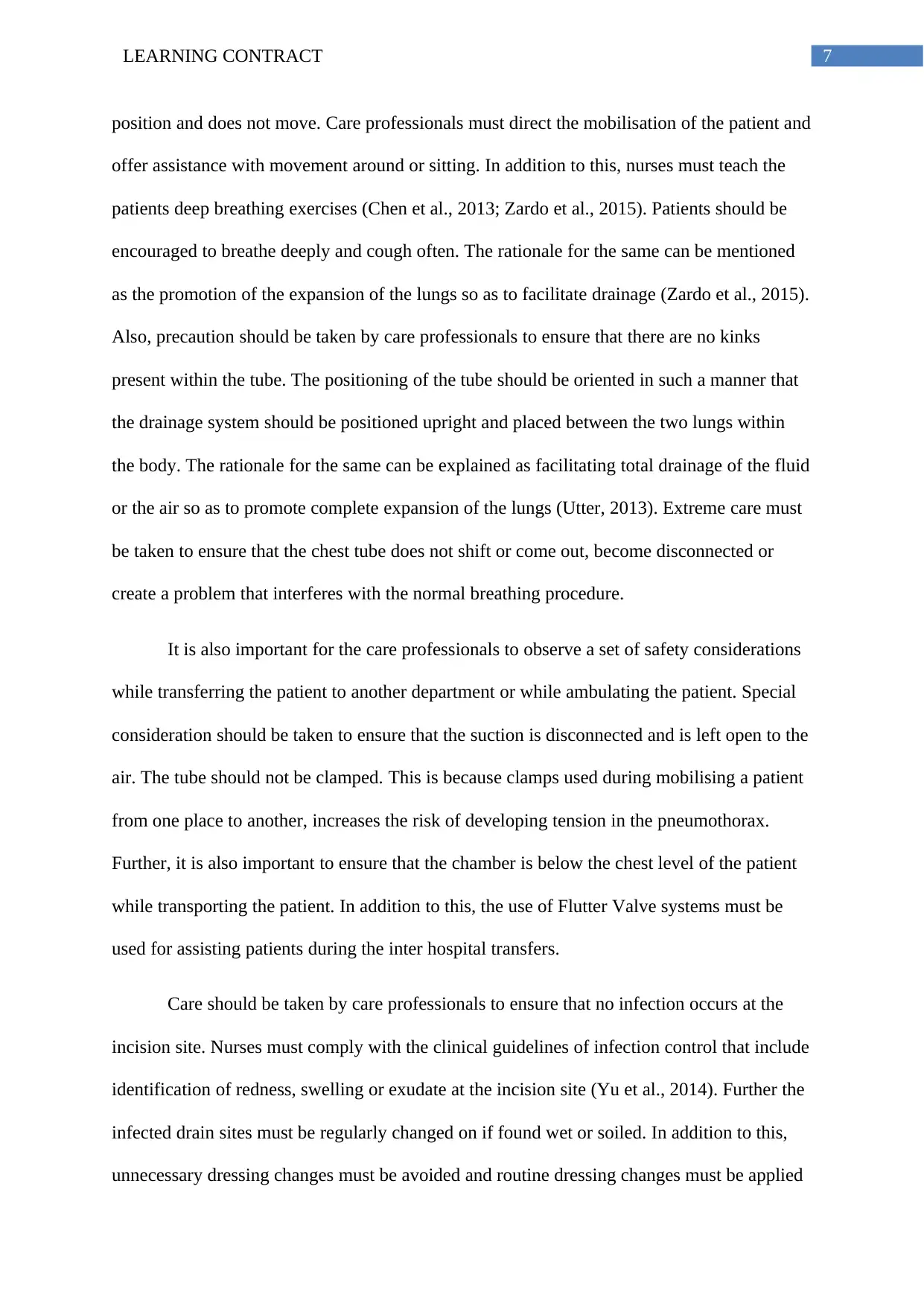
7LEARNING CONTRACT
position and does not move. Care professionals must direct the mobilisation of the patient and
offer assistance with movement around or sitting. In addition to this, nurses must teach the
patients deep breathing exercises (Chen et al., 2013; Zardo et al., 2015). Patients should be
encouraged to breathe deeply and cough often. The rationale for the same can be mentioned
as the promotion of the expansion of the lungs so as to facilitate drainage (Zardo et al., 2015).
Also, precaution should be taken by care professionals to ensure that there are no kinks
present within the tube. The positioning of the tube should be oriented in such a manner that
the drainage system should be positioned upright and placed between the two lungs within
the body. The rationale for the same can be explained as facilitating total drainage of the fluid
or the air so as to promote complete expansion of the lungs (Utter, 2013). Extreme care must
be taken to ensure that the chest tube does not shift or come out, become disconnected or
create a problem that interferes with the normal breathing procedure.
It is also important for the care professionals to observe a set of safety considerations
while transferring the patient to another department or while ambulating the patient. Special
consideration should be taken to ensure that the suction is disconnected and is left open to the
air. The tube should not be clamped. This is because clamps used during mobilising a patient
from one place to another, increases the risk of developing tension in the pneumothorax.
Further, it is also important to ensure that the chamber is below the chest level of the patient
while transporting the patient. In addition to this, the use of Flutter Valve systems must be
used for assisting patients during the inter hospital transfers.
Care should be taken by care professionals to ensure that no infection occurs at the
incision site. Nurses must comply with the clinical guidelines of infection control that include
identification of redness, swelling or exudate at the incision site (Yu et al., 2014). Further the
infected drain sites must be regularly changed on if found wet or soiled. In addition to this,
unnecessary dressing changes must be avoided and routine dressing changes must be applied
position and does not move. Care professionals must direct the mobilisation of the patient and
offer assistance with movement around or sitting. In addition to this, nurses must teach the
patients deep breathing exercises (Chen et al., 2013; Zardo et al., 2015). Patients should be
encouraged to breathe deeply and cough often. The rationale for the same can be mentioned
as the promotion of the expansion of the lungs so as to facilitate drainage (Zardo et al., 2015).
Also, precaution should be taken by care professionals to ensure that there are no kinks
present within the tube. The positioning of the tube should be oriented in such a manner that
the drainage system should be positioned upright and placed between the two lungs within
the body. The rationale for the same can be explained as facilitating total drainage of the fluid
or the air so as to promote complete expansion of the lungs (Utter, 2013). Extreme care must
be taken to ensure that the chest tube does not shift or come out, become disconnected or
create a problem that interferes with the normal breathing procedure.
It is also important for the care professionals to observe a set of safety considerations
while transferring the patient to another department or while ambulating the patient. Special
consideration should be taken to ensure that the suction is disconnected and is left open to the
air. The tube should not be clamped. This is because clamps used during mobilising a patient
from one place to another, increases the risk of developing tension in the pneumothorax.
Further, it is also important to ensure that the chamber is below the chest level of the patient
while transporting the patient. In addition to this, the use of Flutter Valve systems must be
used for assisting patients during the inter hospital transfers.
Care should be taken by care professionals to ensure that no infection occurs at the
incision site. Nurses must comply with the clinical guidelines of infection control that include
identification of redness, swelling or exudate at the incision site (Yu et al., 2014). Further the
infected drain sites must be regularly changed on if found wet or soiled. In addition to this,
unnecessary dressing changes must be avoided and routine dressing changes must be applied
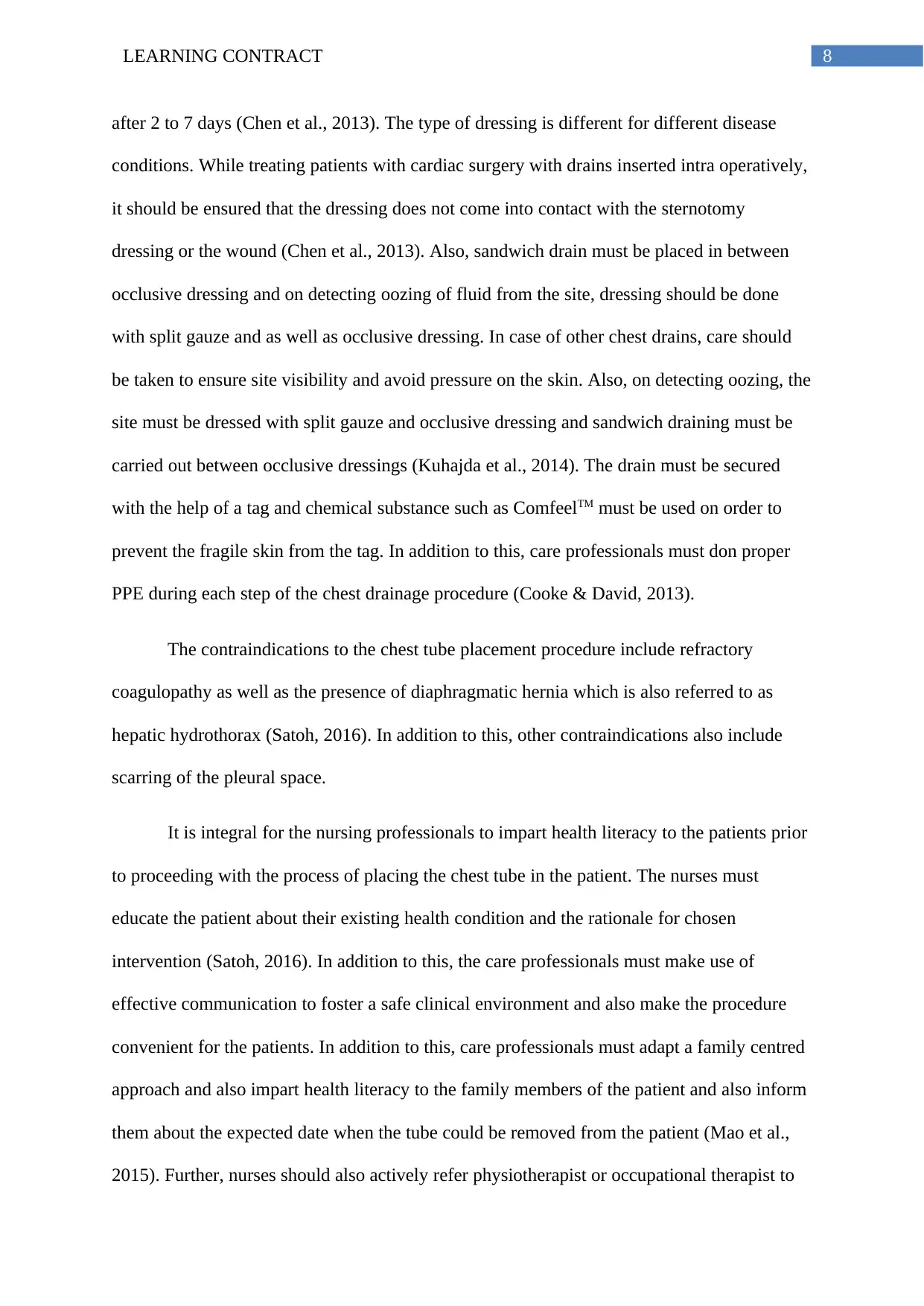
8LEARNING CONTRACT
after 2 to 7 days (Chen et al., 2013). The type of dressing is different for different disease
conditions. While treating patients with cardiac surgery with drains inserted intra operatively,
it should be ensured that the dressing does not come into contact with the sternotomy
dressing or the wound (Chen et al., 2013). Also, sandwich drain must be placed in between
occlusive dressing and on detecting oozing of fluid from the site, dressing should be done
with split gauze and as well as occlusive dressing. In case of other chest drains, care should
be taken to ensure site visibility and avoid pressure on the skin. Also, on detecting oozing, the
site must be dressed with split gauze and occlusive dressing and sandwich draining must be
carried out between occlusive dressings (Kuhajda et al., 2014). The drain must be secured
with the help of a tag and chemical substance such as ComfeelTM must be used on order to
prevent the fragile skin from the tag. In addition to this, care professionals must don proper
PPE during each step of the chest drainage procedure (Cooke & David, 2013).
The contraindications to the chest tube placement procedure include refractory
coagulopathy as well as the presence of diaphragmatic hernia which is also referred to as
hepatic hydrothorax (Satoh, 2016). In addition to this, other contraindications also include
scarring of the pleural space.
It is integral for the nursing professionals to impart health literacy to the patients prior
to proceeding with the process of placing the chest tube in the patient. The nurses must
educate the patient about their existing health condition and the rationale for chosen
intervention (Satoh, 2016). In addition to this, the care professionals must make use of
effective communication to foster a safe clinical environment and also make the procedure
convenient for the patients. In addition to this, care professionals must adapt a family centred
approach and also impart health literacy to the family members of the patient and also inform
them about the expected date when the tube could be removed from the patient (Mao et al.,
2015). Further, nurses should also actively refer physiotherapist or occupational therapist to
after 2 to 7 days (Chen et al., 2013). The type of dressing is different for different disease
conditions. While treating patients with cardiac surgery with drains inserted intra operatively,
it should be ensured that the dressing does not come into contact with the sternotomy
dressing or the wound (Chen et al., 2013). Also, sandwich drain must be placed in between
occlusive dressing and on detecting oozing of fluid from the site, dressing should be done
with split gauze and as well as occlusive dressing. In case of other chest drains, care should
be taken to ensure site visibility and avoid pressure on the skin. Also, on detecting oozing, the
site must be dressed with split gauze and occlusive dressing and sandwich draining must be
carried out between occlusive dressings (Kuhajda et al., 2014). The drain must be secured
with the help of a tag and chemical substance such as ComfeelTM must be used on order to
prevent the fragile skin from the tag. In addition to this, care professionals must don proper
PPE during each step of the chest drainage procedure (Cooke & David, 2013).
The contraindications to the chest tube placement procedure include refractory
coagulopathy as well as the presence of diaphragmatic hernia which is also referred to as
hepatic hydrothorax (Satoh, 2016). In addition to this, other contraindications also include
scarring of the pleural space.
It is integral for the nursing professionals to impart health literacy to the patients prior
to proceeding with the process of placing the chest tube in the patient. The nurses must
educate the patient about their existing health condition and the rationale for chosen
intervention (Satoh, 2016). In addition to this, the care professionals must make use of
effective communication to foster a safe clinical environment and also make the procedure
convenient for the patients. In addition to this, care professionals must adapt a family centred
approach and also impart health literacy to the family members of the patient and also inform
them about the expected date when the tube could be removed from the patient (Mao et al.,
2015). Further, nurses should also actively refer physiotherapist or occupational therapist to
You're viewing a preview
Unlock full access by subscribing today!

9LEARNING CONTRACT
the patient and at the same time make the family members aware about the pain relief
measures that could be used to provide relief to the patient (Yu et al., 2014).
the patient and at the same time make the family members aware about the pain relief
measures that could be used to provide relief to the patient (Yu et al., 2014).
Paraphrase This Document
Need a fresh take? Get an instant paraphrase of this document with our AI Paraphraser

10LEARNING CONTRACT
Evaluation:
The findings accumulated from the scholarly literatures exposes a gamut ok
knowledge about the nuances involved in the procedure of chest drainage. The understanding
level of the evidence base would be evaluated on the basis of the Benner’s Model of clinical
competence (Elliott & Walden, 2015). The Dreyfus model mentions that in the process of
development and acquisition of a skill, a learner is entitled to traverse through five levels of
competence that include, novice, advanced beginner, competent, proficient and expert
(Thomas & Kellgren, 2017). Typically changes across these levels reflect across three areas
of performance which include,
Movement from dependence on abstract principles to the structuring of paradigms
based on past experience
Inducing change in the perception of the learner to analyse the reliability of the
situation
Transition from an observer to a performer who can actively engage with the situation
While creating the learning contract, I was a novice who wanted to acquire knowledge
about the research topic. After conducting an exhaustive review of literatures about the topic
I am placed at the advanced beginner stage. Upon performing the procedure under
supervision, I would become competent. Finally after acquiring several years of experience, I
would become proficient and on guiding another novice to perform the procedure, I would
become an expert.
Evaluation:
The findings accumulated from the scholarly literatures exposes a gamut ok
knowledge about the nuances involved in the procedure of chest drainage. The understanding
level of the evidence base would be evaluated on the basis of the Benner’s Model of clinical
competence (Elliott & Walden, 2015). The Dreyfus model mentions that in the process of
development and acquisition of a skill, a learner is entitled to traverse through five levels of
competence that include, novice, advanced beginner, competent, proficient and expert
(Thomas & Kellgren, 2017). Typically changes across these levels reflect across three areas
of performance which include,
Movement from dependence on abstract principles to the structuring of paradigms
based on past experience
Inducing change in the perception of the learner to analyse the reliability of the
situation
Transition from an observer to a performer who can actively engage with the situation
While creating the learning contract, I was a novice who wanted to acquire knowledge
about the research topic. After conducting an exhaustive review of literatures about the topic
I am placed at the advanced beginner stage. Upon performing the procedure under
supervision, I would become competent. Finally after acquiring several years of experience, I
would become proficient and on guiding another novice to perform the procedure, I would
become an expert.
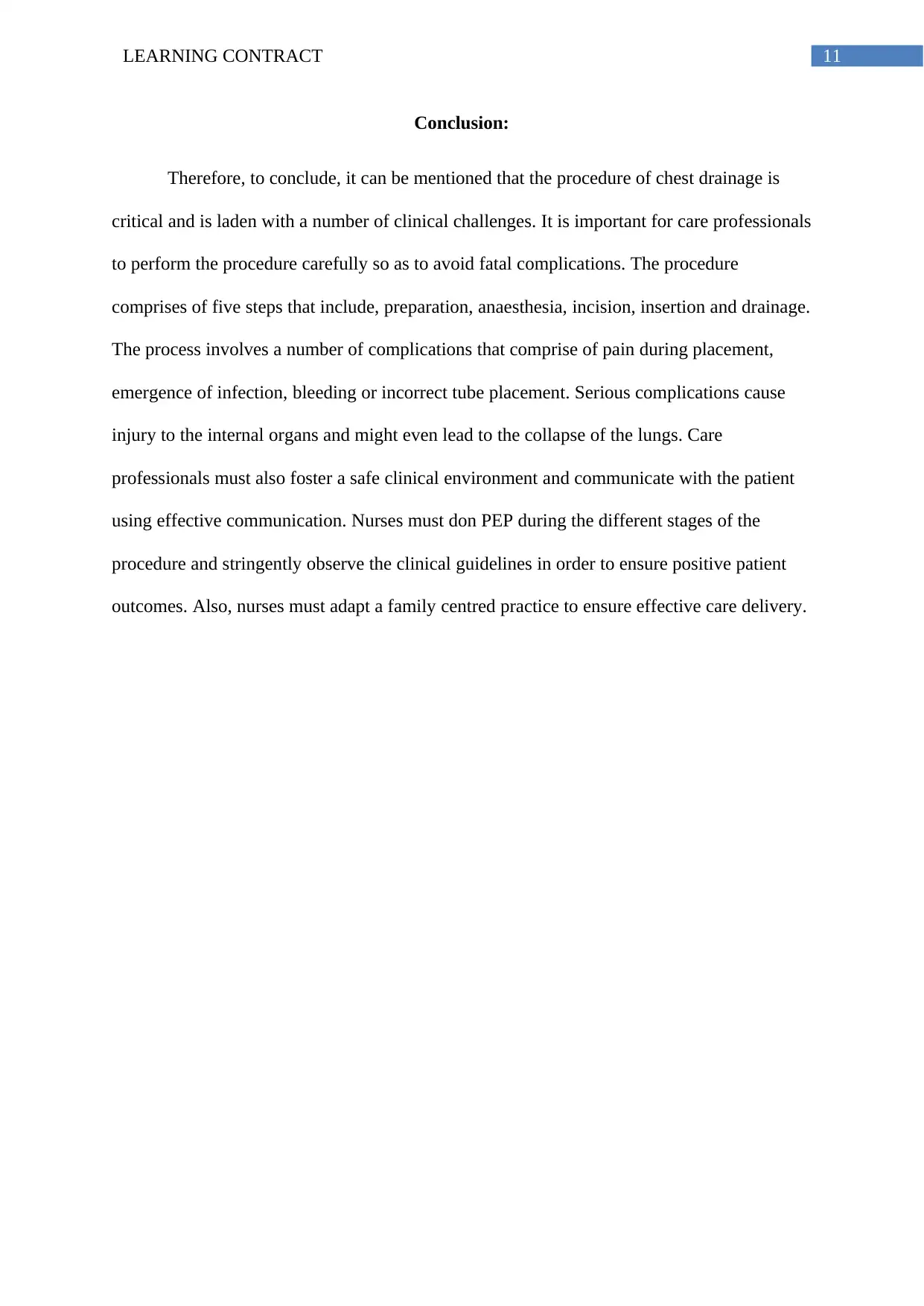
11LEARNING CONTRACT
Conclusion:
Therefore, to conclude, it can be mentioned that the procedure of chest drainage is
critical and is laden with a number of clinical challenges. It is important for care professionals
to perform the procedure carefully so as to avoid fatal complications. The procedure
comprises of five steps that include, preparation, anaesthesia, incision, insertion and drainage.
The process involves a number of complications that comprise of pain during placement,
emergence of infection, bleeding or incorrect tube placement. Serious complications cause
injury to the internal organs and might even lead to the collapse of the lungs. Care
professionals must also foster a safe clinical environment and communicate with the patient
using effective communication. Nurses must don PEP during the different stages of the
procedure and stringently observe the clinical guidelines in order to ensure positive patient
outcomes. Also, nurses must adapt a family centred practice to ensure effective care delivery.
Conclusion:
Therefore, to conclude, it can be mentioned that the procedure of chest drainage is
critical and is laden with a number of clinical challenges. It is important for care professionals
to perform the procedure carefully so as to avoid fatal complications. The procedure
comprises of five steps that include, preparation, anaesthesia, incision, insertion and drainage.
The process involves a number of complications that comprise of pain during placement,
emergence of infection, bleeding or incorrect tube placement. Serious complications cause
injury to the internal organs and might even lead to the collapse of the lungs. Care
professionals must also foster a safe clinical environment and communicate with the patient
using effective communication. Nurses must don PEP during the different stages of the
procedure and stringently observe the clinical guidelines in order to ensure positive patient
outcomes. Also, nurses must adapt a family centred practice to ensure effective care delivery.
You're viewing a preview
Unlock full access by subscribing today!
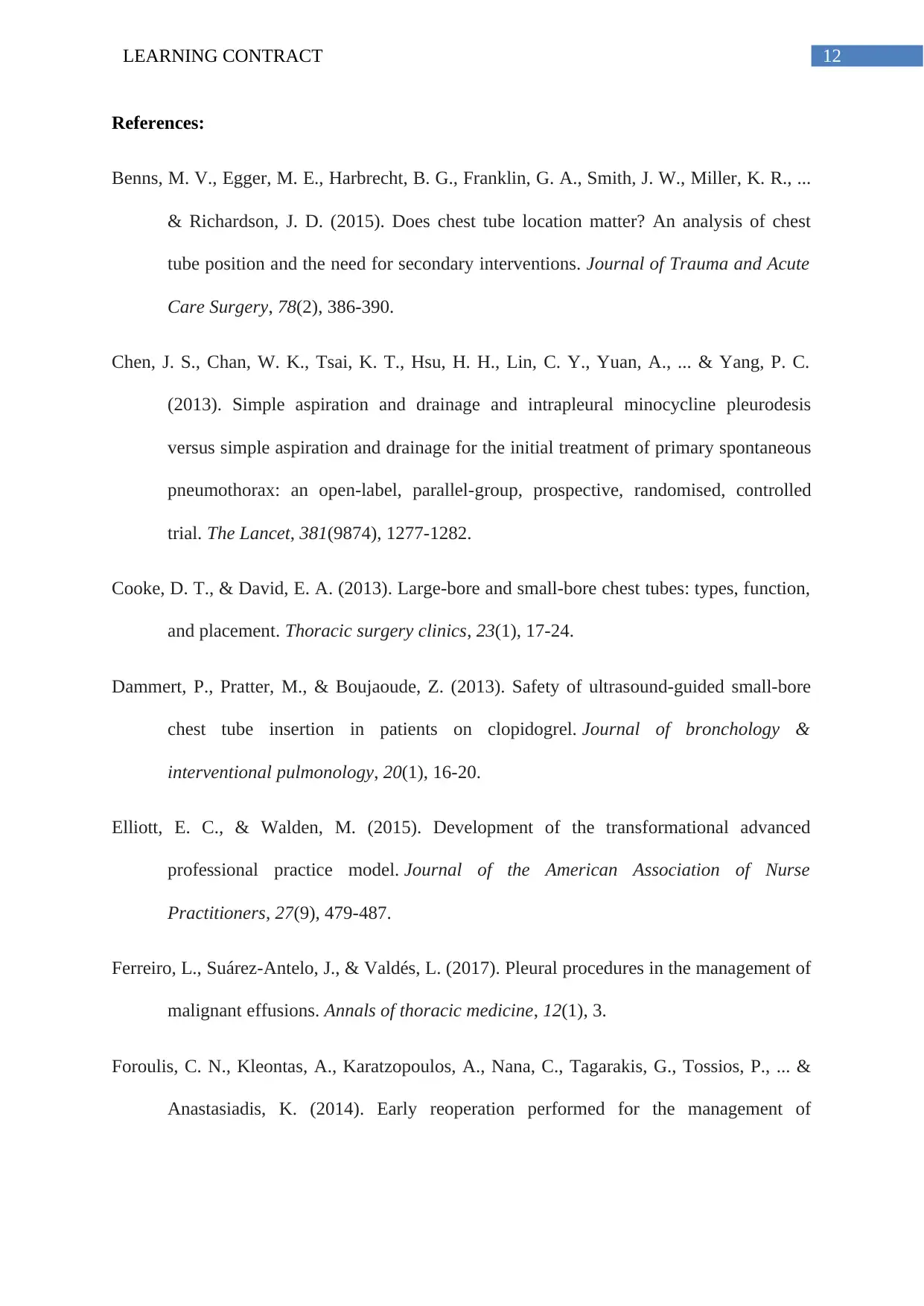
12LEARNING CONTRACT
References:
Benns, M. V., Egger, M. E., Harbrecht, B. G., Franklin, G. A., Smith, J. W., Miller, K. R., ...
& Richardson, J. D. (2015). Does chest tube location matter? An analysis of chest
tube position and the need for secondary interventions. Journal of Trauma and Acute
Care Surgery, 78(2), 386-390.
Chen, J. S., Chan, W. K., Tsai, K. T., Hsu, H. H., Lin, C. Y., Yuan, A., ... & Yang, P. C.
(2013). Simple aspiration and drainage and intrapleural minocycline pleurodesis
versus simple aspiration and drainage for the initial treatment of primary spontaneous
pneumothorax: an open-label, parallel-group, prospective, randomised, controlled
trial. The Lancet, 381(9874), 1277-1282.
Cooke, D. T., & David, E. A. (2013). Large-bore and small-bore chest tubes: types, function,
and placement. Thoracic surgery clinics, 23(1), 17-24.
Dammert, P., Pratter, M., & Boujaoude, Z. (2013). Safety of ultrasound-guided small-bore
chest tube insertion in patients on clopidogrel. Journal of bronchology &
interventional pulmonology, 20(1), 16-20.
Elliott, E. C., & Walden, M. (2015). Development of the transformational advanced
professional practice model. Journal of the American Association of Nurse
Practitioners, 27(9), 479-487.
Ferreiro, L., Suárez-Antelo, J., & Valdés, L. (2017). Pleural procedures in the management of
malignant effusions. Annals of thoracic medicine, 12(1), 3.
Foroulis, C. N., Kleontas, A., Karatzopoulos, A., Nana, C., Tagarakis, G., Tossios, P., ... &
Anastasiadis, K. (2014). Early reoperation performed for the management of
References:
Benns, M. V., Egger, M. E., Harbrecht, B. G., Franklin, G. A., Smith, J. W., Miller, K. R., ...
& Richardson, J. D. (2015). Does chest tube location matter? An analysis of chest
tube position and the need for secondary interventions. Journal of Trauma and Acute
Care Surgery, 78(2), 386-390.
Chen, J. S., Chan, W. K., Tsai, K. T., Hsu, H. H., Lin, C. Y., Yuan, A., ... & Yang, P. C.
(2013). Simple aspiration and drainage and intrapleural minocycline pleurodesis
versus simple aspiration and drainage for the initial treatment of primary spontaneous
pneumothorax: an open-label, parallel-group, prospective, randomised, controlled
trial. The Lancet, 381(9874), 1277-1282.
Cooke, D. T., & David, E. A. (2013). Large-bore and small-bore chest tubes: types, function,
and placement. Thoracic surgery clinics, 23(1), 17-24.
Dammert, P., Pratter, M., & Boujaoude, Z. (2013). Safety of ultrasound-guided small-bore
chest tube insertion in patients on clopidogrel. Journal of bronchology &
interventional pulmonology, 20(1), 16-20.
Elliott, E. C., & Walden, M. (2015). Development of the transformational advanced
professional practice model. Journal of the American Association of Nurse
Practitioners, 27(9), 479-487.
Ferreiro, L., Suárez-Antelo, J., & Valdés, L. (2017). Pleural procedures in the management of
malignant effusions. Annals of thoracic medicine, 12(1), 3.
Foroulis, C. N., Kleontas, A., Karatzopoulos, A., Nana, C., Tagarakis, G., Tossios, P., ... &
Anastasiadis, K. (2014). Early reoperation performed for the management of
Paraphrase This Document
Need a fresh take? Get an instant paraphrase of this document with our AI Paraphraser
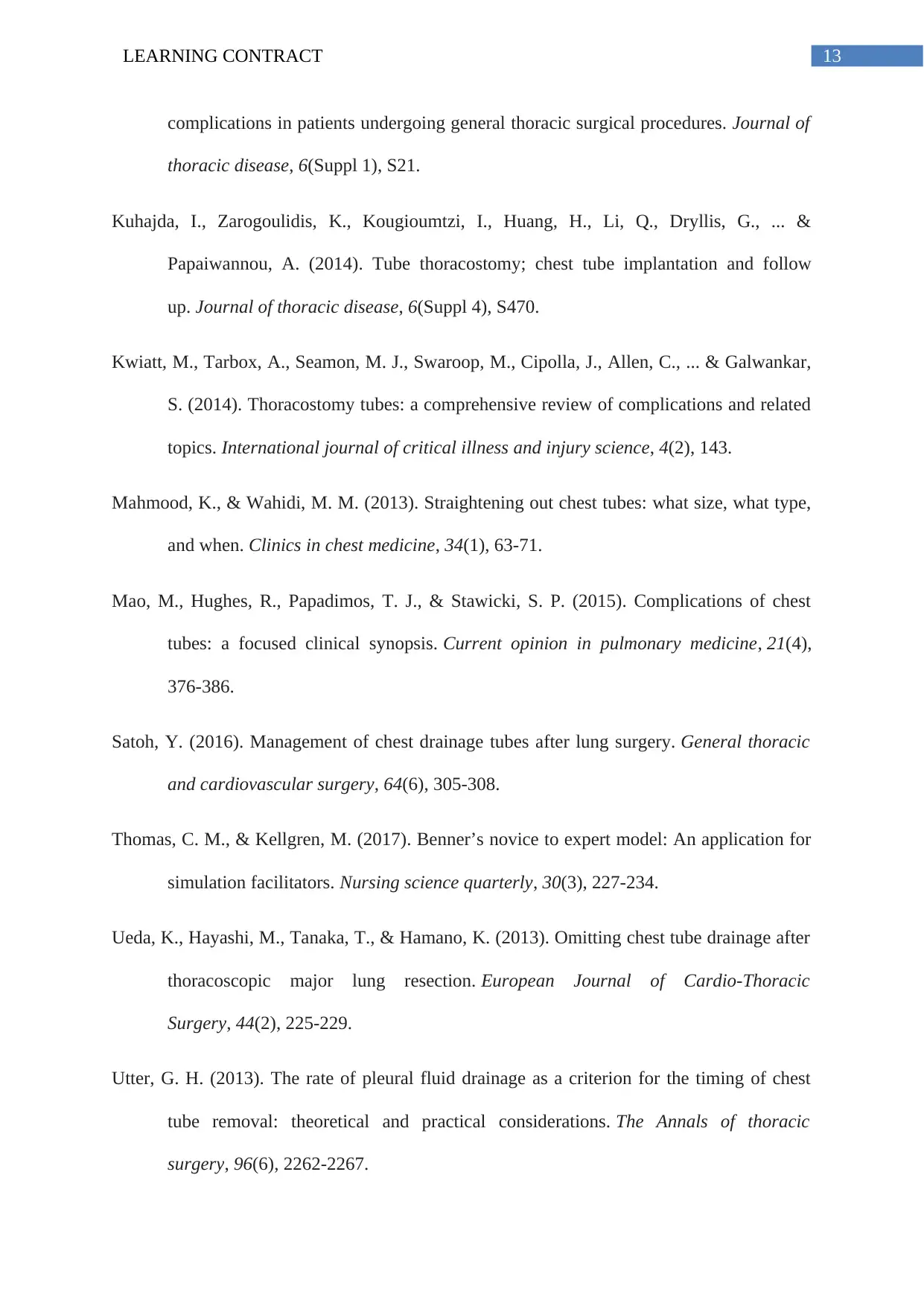
13LEARNING CONTRACT
complications in patients undergoing general thoracic surgical procedures. Journal of
thoracic disease, 6(Suppl 1), S21.
Kuhajda, I., Zarogoulidis, K., Kougioumtzi, I., Huang, H., Li, Q., Dryllis, G., ... &
Papaiwannou, A. (2014). Tube thoracostomy; chest tube implantation and follow
up. Journal of thoracic disease, 6(Suppl 4), S470.
Kwiatt, M., Tarbox, A., Seamon, M. J., Swaroop, M., Cipolla, J., Allen, C., ... & Galwankar,
S. (2014). Thoracostomy tubes: a comprehensive review of complications and related
topics. International journal of critical illness and injury science, 4(2), 143.
Mahmood, K., & Wahidi, M. M. (2013). Straightening out chest tubes: what size, what type,
and when. Clinics in chest medicine, 34(1), 63-71.
Mao, M., Hughes, R., Papadimos, T. J., & Stawicki, S. P. (2015). Complications of chest
tubes: a focused clinical synopsis. Current opinion in pulmonary medicine, 21(4),
376-386.
Satoh, Y. (2016). Management of chest drainage tubes after lung surgery. General thoracic
and cardiovascular surgery, 64(6), 305-308.
Thomas, C. M., & Kellgren, M. (2017). Benner’s novice to expert model: An application for
simulation facilitators. Nursing science quarterly, 30(3), 227-234.
Ueda, K., Hayashi, M., Tanaka, T., & Hamano, K. (2013). Omitting chest tube drainage after
thoracoscopic major lung resection. European Journal of Cardio-Thoracic
Surgery, 44(2), 225-229.
Utter, G. H. (2013). The rate of pleural fluid drainage as a criterion for the timing of chest
tube removal: theoretical and practical considerations. The Annals of thoracic
surgery, 96(6), 2262-2267.
complications in patients undergoing general thoracic surgical procedures. Journal of
thoracic disease, 6(Suppl 1), S21.
Kuhajda, I., Zarogoulidis, K., Kougioumtzi, I., Huang, H., Li, Q., Dryllis, G., ... &
Papaiwannou, A. (2014). Tube thoracostomy; chest tube implantation and follow
up. Journal of thoracic disease, 6(Suppl 4), S470.
Kwiatt, M., Tarbox, A., Seamon, M. J., Swaroop, M., Cipolla, J., Allen, C., ... & Galwankar,
S. (2014). Thoracostomy tubes: a comprehensive review of complications and related
topics. International journal of critical illness and injury science, 4(2), 143.
Mahmood, K., & Wahidi, M. M. (2013). Straightening out chest tubes: what size, what type,
and when. Clinics in chest medicine, 34(1), 63-71.
Mao, M., Hughes, R., Papadimos, T. J., & Stawicki, S. P. (2015). Complications of chest
tubes: a focused clinical synopsis. Current opinion in pulmonary medicine, 21(4),
376-386.
Satoh, Y. (2016). Management of chest drainage tubes after lung surgery. General thoracic
and cardiovascular surgery, 64(6), 305-308.
Thomas, C. M., & Kellgren, M. (2017). Benner’s novice to expert model: An application for
simulation facilitators. Nursing science quarterly, 30(3), 227-234.
Ueda, K., Hayashi, M., Tanaka, T., & Hamano, K. (2013). Omitting chest tube drainage after
thoracoscopic major lung resection. European Journal of Cardio-Thoracic
Surgery, 44(2), 225-229.
Utter, G. H. (2013). The rate of pleural fluid drainage as a criterion for the timing of chest
tube removal: theoretical and practical considerations. The Annals of thoracic
surgery, 96(6), 2262-2267.

14LEARNING CONTRACT
Yu, D., Buchvald, F., Brandt, B., & Nielsen, K. G. (2014). Seventeen‐year study shows rise
in parapneumonic effusion and empyema with higher treatment failure after chest
tube drainage. Acta Paediatrica, 103(1), 93-99.
Zardo, P., Busk, H., & Kutschka, I. (2015). Chest tube management: state of the art. Current
Opinion in Anesthesiology, 28(1), 45-49.
Yu, D., Buchvald, F., Brandt, B., & Nielsen, K. G. (2014). Seventeen‐year study shows rise
in parapneumonic effusion and empyema with higher treatment failure after chest
tube drainage. Acta Paediatrica, 103(1), 93-99.
Zardo, P., Busk, H., & Kutschka, I. (2015). Chest tube management: state of the art. Current
Opinion in Anesthesiology, 28(1), 45-49.
You're viewing a preview
Unlock full access by subscribing today!
1 out of 15
Your All-in-One AI-Powered Toolkit for Academic Success.
+13062052269
info@desklib.com
Available 24*7 on WhatsApp / Email
![[object Object]](/_next/static/media/star-bottom.7253800d.svg)
Unlock your academic potential
© 2024 | Zucol Services PVT LTD | All rights reserved.

